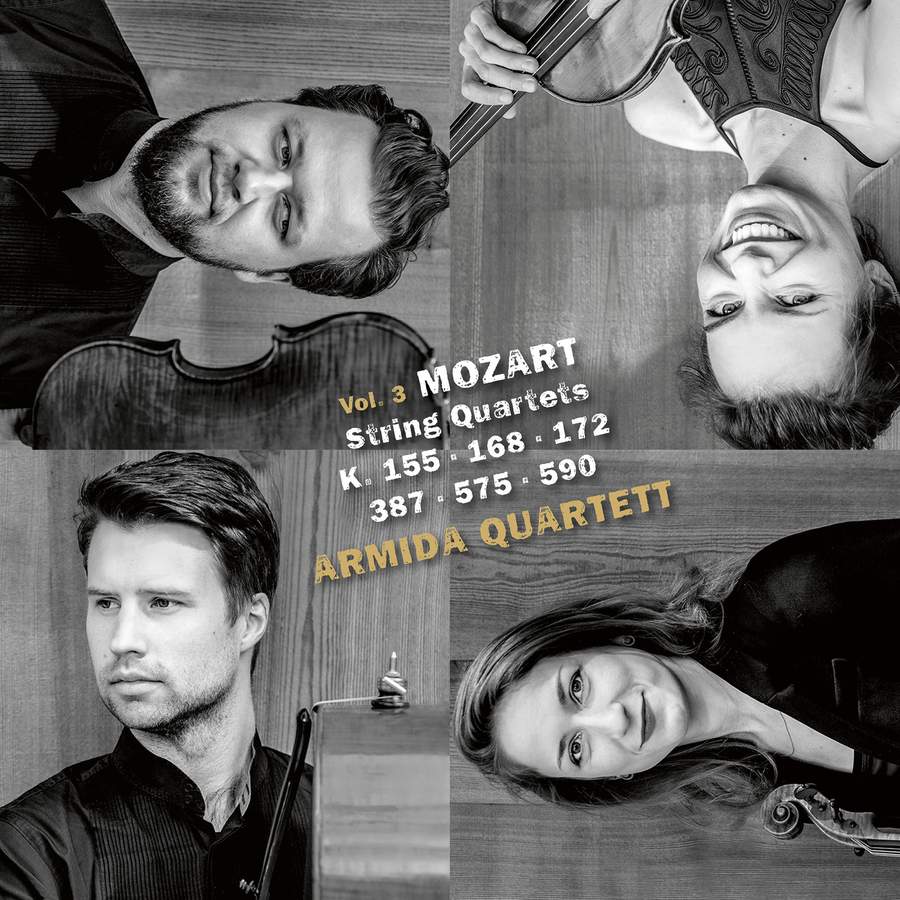MOZART String Quartets Vol 3 (Armida Quartet)
View record and artist detailsRecord and Artist Details
Genre:
Chamber
Label: Avi Music
Magazine Review Date: 04/2021
Media Format: CD or Download
Media Runtime: 115
Mastering:
DDD
Catalogue Number: AVI8553032

Tracks:
| Composition | Artist Credit |
|---|---|
| String Quartet No. 14 |
Wolfgang Amadeus Mozart, Composer
Armida Quartet |
| String Quartet No. 23 |
Wolfgang Amadeus Mozart, Composer
Armida Quartet |
| String Quartet No. 2 |
Wolfgang Amadeus Mozart, Composer
Armida Quartet |
| String Quartet No. 8 |
Wolfgang Amadeus Mozart, Composer
Armida Quartet |
| String Quartet No. 12 |
Wolfgang Amadeus Mozart, Composer
Armida Quartet |
| String Quartet No. 21 |
Wolfgang Amadeus Mozart, Composer
Armida Quartet |
Author: David Threasher
The Armida Quartet’s Mozart cycle operates both as an artistic endeavour and as a musicological one. The players are acting as consultants to the new Urtext edition of the 23 quartets for Henle Verlag, assisting in correcting errors and misreadings that have accrued over the centuries and advising on practical matters. This involvement at the nuts-and-bolts level is audible in a series of performances in which the integrity of the interpretations is enhanced by the convergence of the ensemble’s intimate, ‘inside’ knowledge of the music and a recording that clarifies each voice as a discrete character in the discourse.
This third volume covers almost the entire range of Mozart’s quartet output, from the first work of his first set (1772 73), via two from his second (later in 1773) and the first of the celebrated ‘Haydn’ Quartets (1782), to the first and last of the late works (1789 90) connected with a visit to the cello-playing King Friedrich Wilhelm II of Prussia. The works are organised out of chronological order, to avoid a historicising, ‘evolutionary’ approach. Nevertheless, contrasts between the Italian flavour of K155 and the sudden influence of Haydn’s Op 20 in K168 and 172 are palpable, as is the shift of approach from the collision between buffo styles and austere counterpoint in K387 to the more subtle, emotionally ambivalent works of later in the decade.
These late works are naturally available in any number of recommendable readings but the expressive honesty and textual fidelity of the Armida (BBC New Generation Artists, 2014 16) make these eminently rewarding performances. The earlier works are heard far less often, however, and the seriousness with which they are approached here makes an admirable case for them. Vibrato is used as an effect rather than as a default, and phrasing and address are minutely considered at every moment. This is amply illustrated, for example, in K168, where the later movements traverse from viol-like stillness in the Andante’s sepulchral strict counterpoint, through the sweetness of the Minuet, to the ecstatic outpouring of the closing fugue. This is an accomplished recording of the great quartets from the Vienna decade but, perhaps more importantly, a vital one of the earlier works, demonstrating not only the young Mozart’s gifts but also the unique power and imagination with which the teenage composer was able to deploy them.
Discover the world's largest classical music catalogue with Presto Music.

Gramophone Digital Club
- Digital Edition
- Digital Archive
- Reviews Database
- Full website access
From £8.75 / month
Subscribe
Gramophone Full Club
- Print Edition
- Digital Edition
- Digital Archive
- Reviews Database
- Full website access
From £11.00 / month
Subscribe
If you are a library, university or other organisation that would be interested in an institutional subscription to Gramophone please click here for further information.




